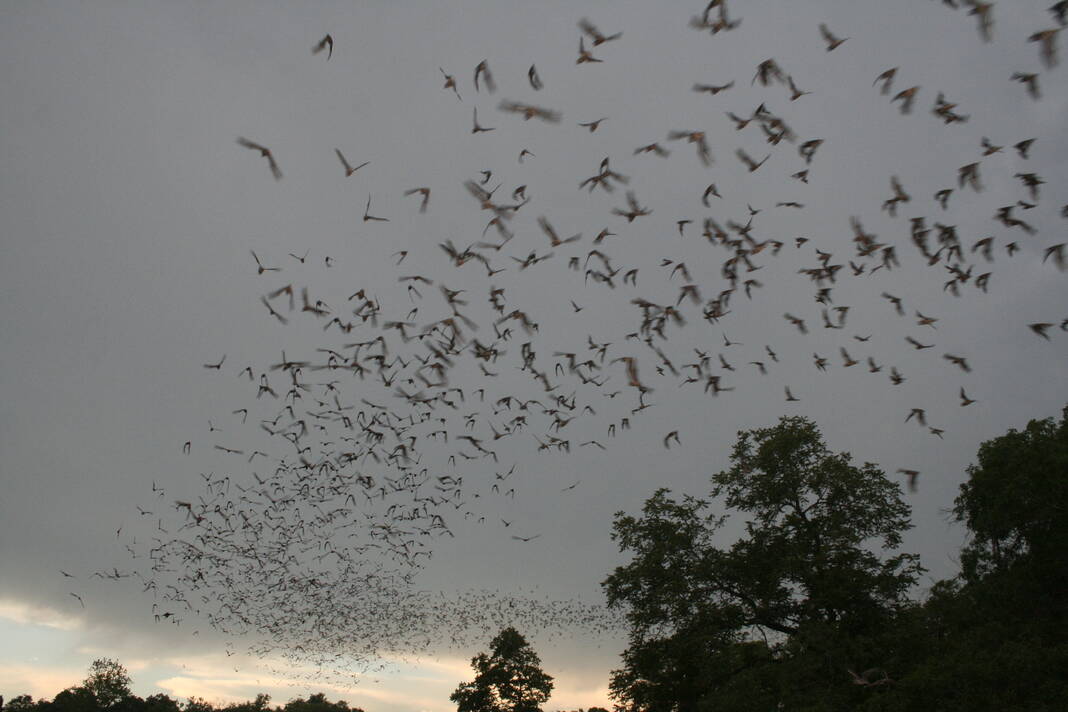
Just in time for Halloween, Bat Week is upon us.
Bat Week, an annual international celebration designed to raise awareness of bat conservation, kicked off Sunday.
Bats really do need the help, and Texas may have the highest population of bats of any state in the nation. It certainly has the most different species with 33.
The problem for bats, and for farmers who save literally billions of dollars a year in crop damage from insects bats eat, according to the U.S. Geological Survey, is a rapidly spreading emergent disease known as white-nose syndrome.
The fatal fungus, which infects the skin, muzzle, ears and wings of hibernating bats, was first discovered in the Northeastern United States in 2007-2008 and has now spread to 38 states, including Texas.
Estimates are it has killed millions of bats, primarily cave-dwelling species, living in cold, damp spaces, which are highly conducive to growing fungus.
The syndrome
The fungus that causes the disease was found in the Panhandle in 2017. The first actual bat victim was discovered at Enchanted Rock State Park near Fredericksburg in 2020.
Nathan Fuller is a bat biologist with the Texas Parks and Wildlife Department. Two summers ago, thanks to funding from the U.S. Fish and Wildlife Service, he and fellow researchers set out to determine the extent of white-nose syndrome in the Texas Hill Country, where dead bats were showing up.
Problem is, nobody really knows how many bats live in Texas, and that creates issues when trying to craft population comparisons.
“We’re a lot further south than most of the other bat populations that have been getting hit pretty hard,” Fuller said. “In addition, these are different species of bats with different hibernation, migration and energetic strategies. We just weren’t sure what the deal was.”
“However, once we started finding dead bats on the landscape, we realized that, ok, it looks like, unexpectedly, yes it does have an impact on bats here,” he added.
The research into maternity roosts, the summer bat roosts, across the Hill Country indicate significant population declines among cave bats.
Fuller stresses the data is only preliminary, but the initial findings are nonetheless startling.
“Our preliminary data suggests that one species of bat called the cave bat has declined close to 80 percent in some of these summer roosts,” Fuller said. “So actually it is a very big impact. Moreso than we expected, really.”
No cave, no problem
Geologically, the Rio Grande Valley doesn’t have the right terrain for limestone caves, but bats are resourceful mammals.
They find a way.
“There are two things about the Rio Grande Valley that are interesting,” Fuller said. “You don’t have caves, but bats are enterprising animals. And what you do have a lot of are highway culverts. And we have records of bats using highway culverts in your area as winter roosting places.”
The world’s largest urban bat colony — an estimated 1.5 million bats — swarms out from underneath the Congress Avenue Bridge in downtown Austin when it comes time to feed in the night.
A similar “batnado” can be seen erupting from the Bracken Cave Preserve in San Antonio as bats emerge to hunt.
Here in the Valley, numerous bats roost in Mission at the Conway Street exit on U.S. Expressway 83.
The second interesting thing is some Valley bats are roosting, almost in secret, in your yard.
Palm havens
Palm trees may not be native to the Rio Grande Valley, but bats have long proved themselves to be resilient in exploiting new habitats.
“The bats that tend to use palm fronds are what we call migratory tree bats. They’re not the same kind of bat as the bats that hibernate in caves throughout the wintertime,” Fuller said.
“Palm fronds are used mostly by, I think it’s the southern yellow bat, and that bat is like other tree bats like the red bat, the hoary bat and the silver-haired bat. They don’t really have a static roost,” he added. “They move around from tree to tree. They take their pups with them as they go. They’re kind of vagrants on the landscape.”
These bats utilizing palm trees are looking for a tree with a good skirt of dead vegetation hanging down from the top, where they roost “happily” says Fuller, staying among the fronds all winter.
“One of the concerns that we have about that species is the practice of trimming palm fronds as like a yard-upkeep approach, yard work approach, that takes away a lot of the roosting habitat for these animals that really do have a limited range in the state,” he added.
Palm upkeep
Bats don’t hibernate but they do go into torpor when the weather is cold, lowering their body temperatures into the 50s to minimize energy expenditure.
It’s also when they are vulnerable to tree-trimming.
“If you go in the wintertime and you trim these things and there are bats in there, there’s nothing a bat can do, it’s just going to come down with the fronds and probably get crushed or put in the trash can or whatever outcome there is,” Fuller said.
The good news for the southern yellow bat, a medium-sized bat covered in sooty yellowish fur, is it recently was de-listed as threatened in Texas, meaning its population appears to be recovering.
“The other time that it’s good to avoid messing with bat roosts is during the maternity season when the moms have their pups,” Fuller said. “For yellow bats, I believe that would be something like May and June or so.”
Fuller said migratory tree bats like the southern yellow bats are good at moving their pups, if they’re old enough, as they cling to the mother as she flies to a new roosting location.
“Our advice is usually just to avoid trimming things during that part of the season when there could very well be vulnerable pups and mothers hanging out inside the roost.”



